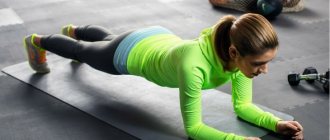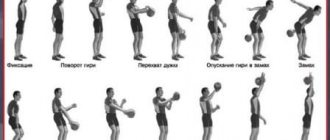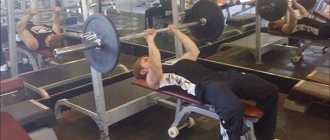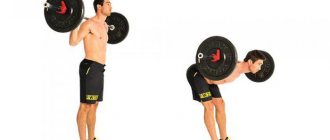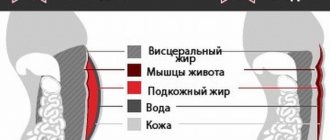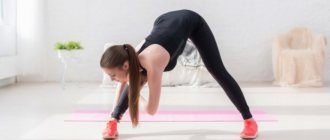An exercise with this name has been familiar to us since childhood. Remember, in kindergarten, among other outdoor games, we moved forward in a line, jumping up from a sitting position and helping ourselves to push off the floor with our hands and feet at the same time?
The classic “Frog” is a more serious element of physical activity than a play option for kids, but it is also quite suitable for children. How to do it, what are its benefits for our body if performed regularly, and what types of exercise exist? Find out everything right now.
Features of the exercise
The frog, like any other abdominal exercise, involves all the abdominal muscles at once. The rectus muscle receives the greatest load. With good development, it is the segments of this muscle, separated by tendon jumpers, that form cubes. In men, the six-pack is more visible due to the lower amount of subcutaneous fat. For women, it is more difficult to achieve a traced relief, however, if desired, nothing is impossible. However, for many girls, a flat stomach and a slender figure are much more important than sculpted muscles.
In addition to the rectus abdominis muscle, frog pull-ups or, more correctly, crunches, use the internal and external oblique muscles. If you want to give these muscles a greater load, you should perform the exercise with the body rotating from side to side.
Abdominal exercises should be performed 20–30 times per set (if you don’t do 20, then as many as you can). Do at least three such approaches. The press should be burning and working to capacity. Many people stop doing the exercise when the first symptoms of muscle fatigue appear. But in the case of abdominal muscles, you need to try to do as many repetitions as possible, despite the burning sensation. Now, if you feel discomfort in the lower back or neck, you should stop the exercise and familiarize yourself with the technique again.
The frog is a fairly safe exercise. However, when it is performed, the pressure in the abdominal cavity increases. Therefore, it is contraindicated in those who have recently undergone operations; girls should not train their abs immediately after childbirth. Be careful with the exercise and strictly follow the technique if you have problems with the spine.
Complicated version
In this variation, the “Frog” exercise for the press (photo 2) looks a little different.
- Sitting on the floor, stretch your legs forward.
- Spread your arms out to the sides.
- With your knees slightly bent, lift your feet off the floor and lift them up at a 45-degree angle. The body is in a V-shaped position. This is the starting position.
- Bring your knees close to your chest and wrap your arms around your legs over your shins.
- Squeeze your abdominal muscles as much as possible and hold in this position for two counts.
- Return to the starting position.
To make the exercise more difficult, keep your legs spread apart in the starting position.
If your abdominal muscles are weak, stretch your arms back and place them on the floor. Keep them in this position for the entire set. This will relieve tension from the lower back (which tends to get very tight when the abdominal muscles are unable to cope with the load).
Repeat 10-15 times.
Common mistakes
When performing abdominal crunches, try to avoid the following mistakes:
- Jerks with the body or legs. All movements must be smooth and controlled.
- Do not lift your body high from the floor. You do crunches, but lifting your torso is a different exercise.
- There should be no arching in the back. If you can't do one more rep without arching your lower back, you've already done your maximum.
- Often, when performing body crunches, there is a desire to press your hands on your head, thereby supposedly helping yourself to rise. This is a misconception - you will only harm your spine.
- Exhale as you force, and inhale as you relax. Improper breathing will significantly reduce the effectiveness of the exercise.
In addition to the frog, you can try oblique crunches and Roman chair sit-ups. There are many abdominal exercises, the main thing is to do them regularly, then the results will not be long in coming.
What are the benefits of Chinese breathing exercises for weight loss?
The exercise system is officially recognized and successfully used in traditional medicine for the prevention and treatment of obesity. Jianfei breathing exercises for weight loss do not involve grueling physical activity. The duration of classes does not exceed 20–30 minutes. Anyone can practice Jianfei breathing techniques. The technique does not involve strict dietary restrictions, due to which weight loss occurs gradually and without harm to health. Chinese gymnastics is useful because it helps:
- normalize acid-base, water-salt balance;
- restore tissue gas exchange;
- reduce excess weight through lipid oxidation;
- rejuvenate the body;
- regulate appetite;
- improve blood circulation;
- speed up metabolism;
- relieve fatigue, nervous tension;
- saturate the body's cells with oxygen;
- start the tissue repair mechanism;
- strengthen the immune system.
Exercise "Frog" on the stomach - a lightweight version
The previous exercise may be beyond the capabilities of beginners. Then you can do a lighter version of the “Frog” on the stomach to strengthen the muscles of the whole body. In yoga it is called Naukasana (boat pose) and is considered a good method of rejuvenating the body and improving digestion.
- Lie on your stomach. Straight legs are extended and lie on the floor, arms are extended forward and are also on the floor.
- Raise your legs and arms extended forward as far as possible. Tighten your whole body.
- Stay in this position for a two count. (Photo 4).
- Lower your arms and legs to the floor, but do not relax your stomach.
Repeat 10-15 times.
This type of “Frog” is also done to compensate for tension in the abdominal muscles.
The indicated number of repetitions is the minimum for each option. In order for any Frog exercise to be effective, the number of times must be increased by 5 every two weeks.
Benefits of Chinese breathing exercises
In the Celestial Empire, the jianfei technique is used in traditional medicine and is not perceived by patients as something mysterious and supernatural. Eastern gymnastics is successfully used to treat many diseases. Chinese doctors claim that the benefits and healing effects of breathing exercises include not only oxygenation and weight loss, but also a special effect on the nervous system.
You only need to do gymnastics for 20-30 minutes a day to ensure a good chance of longevity. There is no need to starve or have special physical training. There is no need to purchase sports equipment or look for a separate room for training. It is better to perform the Jianfei gymnastic complex at home in comfortable clothes. Eastern weight loss techniques help achieve lasting results.
Chinese breathing exercises for weight loss “Jianfei” are very simple, understandable and effective. Already in its very name there is a super prize that you will receive by regularly performing just three simple exercises - “jianfei” translated means “lose fat”. Try it and you will discover the ancient Chinese way of getting rid of ballast!
Lantern of wishes
First, here's some motivation for you, because in order to achieve something, you have to get fired up. And in order to light up, you need to know that you will get your wish fulfilled! So, a survey of those who practice “jianfei” showed: in a couple of days of diligent practice, an average of 1 kg of weight is lost. After one or two months, you may be missing 10 kilos. Isn't that impressive? Especially when you consider that you can exercise anywhere, in anything, at any time. At the same time, no one will require you to demonstrate miracles of dexterity and endurance.
But you will still need strength. Strength of will. Only regular implementation of the complex will give the desired result. Another motivational bonus: the complex contains only three simple exercises that are remembered the first time! And in addition: “jianfei” not only allows you to quickly solve the problem of excess weight, but also heals the body as a whole, gives vital energy and clarifies thoughts.
Favorable exchange
There are still some doubts: “Really! Is it that simple and free? And what, it works?!” To answer this question unambiguously, you must, of course, experience it yourself. Jianfei adherents unanimously claim that yes. There don’t seem to be any selfish motives for talking like that—you won’t make much money from it. So what explains the effect of breathing exercises? The Chinese (and not only them) believe that the basis of the problem of excess weight is a slowdown in metabolism. One of the natural ways to bring it back to normal is proper breathing. By inhaling and exhaling in a certain way, we can activate the body's reserve capacity and speed up our metabolism.
Lyrical digression: metabolism is the intensity with which substances received from food are converted into energy. Everything that is not used to maintain vital functions is stored as fat reserves. Wise Chinese thousands of years ago discovered the relationship between breathing and metabolic processes and learned to adjust metabolism in a healthy way. Jianfei, of course, is not the only breathing practice originating from China. There are many varieties of healing systems based on breathing in this Eastern culture. Judging by the fact that you rarely meet fat people among the descendants of the creators of the Great Wall of China, they know what they are doing.
Three whales
In fact, the whales that Jianfei is based on are called Frog, Lotus and Wave. Ideally, you should master the whole trinity in one sitting 3 times a day. It will take 1 full set about an hour. Another interesting thing is that individual points of the program can be completed when you have 15-20 minutes of free time. Fans of “jianfei” say that the Wave can be practiced in transport (in winter, when clothes disguise your body movements), and at the office desk, and while preparing, for example, borscht. A frog would also probably be suitable for people who have a sedentary job and understanding colleagues. But it is better to leave Lotus for home use - if you sit on the floor with your legs crossed in front of you somewhere in a crowded place, they will not understand you, to put it mildly.
Wave
It is best to start the complex with this exercise. It brings relaxation and concentration. In addition, it dulls the feeling of hunger (after all, you don’t think that you don’t need to follow a diet anymore?), which is why Wave works great as a separate option. Call on him for help whenever the indomitable zhor is ready to defeat you! It was mentioned that you can perform it standing or sitting, but according to the classic version it is proposed to “drive a wave” in a supine position:
- Lie on your back, bend your knees at a right angle. Place your feet parallel to each other. Place one palm on the center of your abdomen and the other on your chest (Fig. 1.).
- Inhale through your nose so that the air fills your chest to capacity. At the same time, pull your stomach in as much as possible. Stay in this position for a couple of seconds.
- Now exhale through your mouth. At the same time as you exhale, draw in your chest and inflate your stomach. Hold your breath again for 2 seconds.
And so over and over again, bringing the number of cycles to 40. At first, even a dozen such “waves” may not seem so simple to you. But when you get used to it and your strength increases, you will easily cope with this exercise.
Frog
This exercise also tames the appetite, but its main purpose is to quickly tone the body. It is more capable of invigorating you than coffee or any artificial energy drink, even when your strength is running low, so it is better to refrain from doing it before bed. To understand the technique, you can imagine a frog: it sits with its eyes bulging and its belly inflates and deflates. In general, here only your stomach works, your chest remains alone. There is no need to bulge your eyes, but if you really want to, you can.
- Sit on a chair. Place your feet shoulder-width apart so that they form a right angle with respect to the floor.
- Bend your arms and rest your elbows on your knees (Fig. 2.).
- Make a fist with one hand and place the other on top, clasping your fist. Attention! For women, the left one is clenched in a fist, and the right one is on top. For men it’s the other way around (who knows why this is so, but apparently there is some secret meaning in this).
- Press your forehead into your fist. Close your eyes, try to let go of all bad thoughts, get away from the hustle and bustle and relax.
- Inhale through your nose, trying to stick your stomach out as much as possible. At the moment when you feel that it is filled to the limit, take another short sharp breath.
- Exhale slowly through your mouth and draw in your stomach as you do so.
Breathe “like a frog” for 15 minutes. It is recommended to do the Frog three times a day. Try to think about something pleasant during the process, for example, visualize how your fats are burned, or imagine the final result - your slim, strong body. After finishing the stage, do not stand up abruptly - you may feel dizzy! And pay attention to the contraindications for this exercise! It cannot be performed: after surgery, with hypertension, gastric and intestinal bleeding, during menstruation.
Lotus
This exercise is compared to meditation. It normalizes metabolism and helps relieve fatigue. From the name it is clear that it is done in the well-known “lotus” position, sitting on the floor with crossed legs. Ideally, your knees should be pointing straight out to the sides and touching the floor. The right one is below, the left one is above. Don't let the lack of stretching scare you - if you can't do everything exactly, just cross your legs as best you can.
- Place your hands palms up, right on top of left. For men it’s the opposite. Lower them onto your legs in front of your stomach (Fig. 3.).
- Keep your back straight and your shoulders and chin down slightly. Close your eyes and touch the tip of your tongue to the upper palate (mouth closed!).
- Inhale deeply through your nose and imagine something pleasant and joyful. Listen to yourself, feel peace.
- Breathe silently, deeply and calmly for 5 minutes, but concentrate on your breathing to even it out.
- Breathe for 5 minutes as usual - relaxed and free, controlling only the exhalation. Inhale naturally and exhale through your mouth very long and silently.
- For 10 minutes in the finale, forget about breathing altogether. No, don't forget to breathe! Just inhale and exhale uncontrollably as needed. And try not to think about anything at all. This is perhaps the most difficult thing!
When setting yourself a great goal - losing weight, try to do the Lotus exercise 3 times a day. If your goal is general health promotion, once is enough.
This exercise, like jianfei gymnastics in general, helps not only to get in shape and maintain it, but also gives you something much more valuable - the feeling that you live in harmony with yourself and the world.
